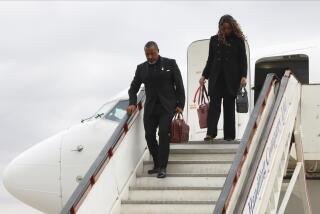After 47 Years, Death of World War II Flier Is Solved; Arlington Burial Planned
- Share via
For 47 years, the family of a World War II veteran who was reported missing in action never knew how he died.
But now, the family of Staff Sgt. Walter P. Szeliga--including nephew Dennis Maloziec of Huntington Beach--is planning for the burial of the turret gunner’s remains, after Army representatives informed them that Szeliga’s downed plane was discovered in the South Pacific.
“My grandmother always held out hope that he had amnesia and was alive but lost in the New Guinea jungle,” Maloziec said Wednesday of his uncle’s mother, who died in Detroit in 1973.
Two weeks ago, the U.S. military informed Maloziec’s family of the discovery. However, the remains were not in the ocean off New Guinea, as initially reported on Dec. 20, 1942, but at a crash site on a mountainside near the New Guinea village of Tsili Tsili.
The disappearance of the 23-year-old flier had always puzzled the proud Polish family from Detroit’s northeast suburb of Center Line, Maloziec said.
Although he never met his uncle, who was known as “Slug” Szeliga, the 40-year-old Maloziec said that two years ago he told his mother about “weird emotions” he had toward his uncle and his disappearance.
“I asked my mom for his photographs, all his letters to the family and even the military letters about his disappearance. It was weird. I wanted to know everything about him,” said Maloziec.
Maloziec said it could have had something to do with fate. Ever since he served in the U.S. Air Force from 1968 to 1971 and his mother put his military picture next to his uncle’s photograph on her dresser, “I feel as if I’ve been bonded in some way to my uncle.”
On Dec. 20, 1942, Szeliga was part of a 10-man crew aboard a B-24 Liberator bomber that was reported missing while on an armed reconnaissance mission over Japanese territory in the Solomon Islands.
“They were to return at nightfall, and were on final approach at a New Guinea airport when they radioed the tower to put the runway lights on,” Maloziec said.
“That’s the last they ever heard from them,” he said.
A few weeks later, the family received a letter from Szeliga’s commanding officer of the 400th Bomber Squadron 90th Bomber Group based at Iron Range, Australia.
“We regret to inform you that . . . (Szeliga) is missing in action,” the letter stated.
According to the military, there are more than 78,000 American military personnel still missing in action from World War II.
In New Guinea alone, there are an estimated 300 crash sites that the military “is not actively searching for because of the jungle terrain,” said Shari Lawrence, a spokeswoman for the U.S. Total Army Personnel Command in Alexandria, Va.
The plane was first spotted in 1984. However, efforts to recover it were unsuccessful.
But in June, 1987, a mining company’s research team took aerial photographs of identifiable metal parts and the military once again launched a recovery team that found the crash site.
“They first found parts of it, but confirmed the discovery with a call sign plate on the instrument panel and with part of the plane’s tail,” Maloziec said.
Relatives of only seven of the 10 crew members have been notified of the discovery, Lawrence said. It will take a few more weeks until a complete notification has been made, she said, which will delay burial.
A group burial, possibly at Arlington National Cemetery with a full military ceremony, is being planned, Maloziec said.
“After all these years, we finally get to bury uncle Szeliga,” he said.
More to Read
Sign up for Essential California
The most important California stories and recommendations in your inbox every morning.
You may occasionally receive promotional content from the Los Angeles Times.













